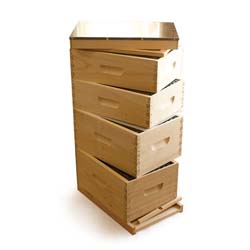Honeybee populations and the beekeepers that support them are important to entire ecosystems around them, making it integral that we do our part to ensure their populations stay healthy. Understanding the factors that help bees mitigate threats and be able to not just survive, but thrive, can make all the difference in maintaining the health of your bees (and the success of your hobby, too).
To maintain their colony’s growth, honeybees must expend a LOT of energy to do the work that’s required, both inside and out of their beehive. To build wax, raise and feed developing bees nutritiously, and have enough stored resources, worker bees remain busy taking foraging trips to bring back pollen and nectar. For bees to have enough of these resources to consume for the energy they need now and to store for later (like during the winter months), they require a wide variety of flowers and plants that provide valuable sources, blooming at various times of the year. Ensuring that bees have access to good foraging sources is essential, if few exist near your bee yard, consider planting some!
But it’s not just about what’s near their hives; honeybees need the right environment and conditions inside the hive, too. A beekeeper should help maintain their colony’s needs by paying close attention and making note of what they see inside during regular beehive inspections. Bees are able to manage the conditions and space inside their hive on their own quite well but helping them by ensuring they have proper ventilation (and there is NOT too much excess moisture), adding a feeder when resources aren’t enough to sustain growth, and helping them to manage potential pests or diseases can make their jobs much easier.
Many pests and diseases put honeybee colonies at risk. Find out about the biggest threats bees face here, and head to the “Read More” section of that post (or this one!) for more resources on your part in managing them.
Honeybees do their best to help themselves and future generations of bees by working to maintain healthy and diverse genetics among future populations. It may be hard to believe, but drone bees are the star of this show and actually do a lot to help with the diversity part. They do participate in mating with a queen, which aids in the reproduction cycle for individual bees, but they also help the entire population by doing so in a way that ensures future genetic diversity. Plenty of healthy drones means healthier future generations of honeybees, better able to withstand diseases, are stronger physically, and could have more hygienic behaviors that help in fighting in-hive parasites and other pests, like varroa mites.
To thrive, honeybee colonies need diverse forage, a safe hive environment, minimal exposure to threats and pesticides, and strong genetics. By working with other beekeepers, farmers, gardeners, and agricultural agencies, we can support growing and thriving honeybee populations.
Read More
A Practical Guide to a Thriving Colony
What is “Integrated Pest Management”?
Tips & Tricks for Providing Pollinator-Friendly Plants
When, What, and How to Feed Honeybees
Tracking Honeybee Hive Progress And Keeping Records *
Thoughts on Responsible Beekeeping *
* Colony Member-Only Content
